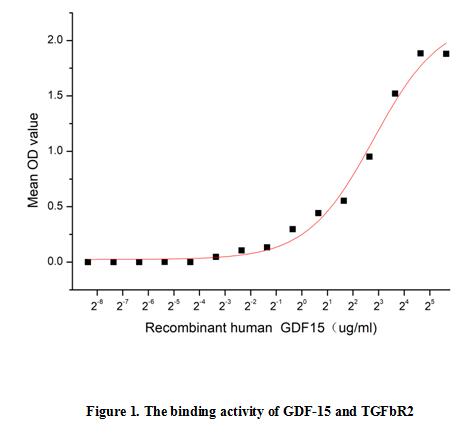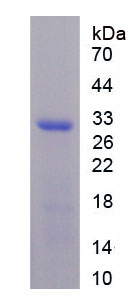Active Growth Differentiation Factor 15 (GDF15) 

PDF; MIC1; NAG-1; PLAB; PTGFB; Macrophage inhibitory cytokine 1; NSAID-activated gene 1 protein; Placental bone morphogenetic protein; Prostate differentiation factor
- UOM
- FOB US$ 204.00 US$ 510.00 US$ 1,020.00 US$ 3,060.00 US$ 7,650.00
- Quantity
Overview
Properties
- Product No.APC034Hu62
- Organism SpeciesHomo sapiens (Human) Same name, Different species.
- ApplicationsCell culture; Activity Assays.
Research use only - DownloadInstruction Manual
- CategoryCytokineApoptosisTumor immunityInfection immunity
- Buffer FormulationPBS, pH7.4, containing 5% Trehalose.
- Traits Freeze-dried powder, Purity > 95%
- Isoelectric Point7.9
Sign into your account
Share a new citation as an author
Upload your experimental result
Review

Contact us
Please fill in the blank.
Activity test

Growth Differentiation Factor 15 (GDF-15), also called Macrophage Inhibitory Cytokine 1 (MIC-1), is a divergent member of the Transforming Growth Factor beta (TGF-beta ) superfamily. Human GDF-15 shares 66% and 68% amino acid sequence identity with the rat and mouse proteins, respectively. GDF-15 is highly expressed in placenta and brain, and it is expressed at lower levels in kidney, pancreas, prostate, and colon. Similar to other TGF-beta family proteins, GDF-15 is synthesized as a large precursor protein that is cleaved at a dibasic cleavage site (RxxR) to release the mature protein. Biologically active GDF-15 is a disulfide-linked homodimer of the mature protein. GDF 15 has been shown to have various functions, including inhibition of Tumor Necrosis Factor alpha (TNF-alpha ) production from lipopolysaccharide-stimulated macrophages and the induction of cartilage formation. A functional ELISA assay was conducted to detect the interaction of recombinant human GDF-15 and recombinant human Transforming Growth Factor Beta Receptor II (TGFbR2). Briefly, biotin-linked GDF-15 were diluted serially in PBS, with 0.01% BSA (pH 7.4). Duplicate samples of 100 ul were then transferred to TGFbR2-coated microtiter wells and incubated for 1h at 37 ℃. Wells were washed with PBST 3 times and incubation with Streptavidin-HRP for 30min, then wells were aspirated and washed 5 times. With the addition of substrate solution, wells were incubated 15-25 minutes at 37 ℃. Finally, add 50 µl stop solution to the wells and read at 450 nm immediately. The binding activity of GDF-15 and TGFbR2 was shown in Figure 1, the EC50 for this effect is 7.002 ug/mL.
Usage
Reconstitute in 10mM PBS (pH7.4) to a concentration of 0.1-1.0 mg/mL. Do not vortex.
Storage
Avoid repeated freeze/thaw cycles. Store at 2-8°C for one month. Aliquot and store at -80°C for 12 months.
Stability
The thermal stability is described by the loss rate. The loss rate was determined by accelerated thermal degradation test, that is, incubate the protein at 37°C for 48h, and no obvious degradation and precipitation were observed. The loss rate is less than 5% within the expiration date under appropriate storage condition.
Increment services
-
 BCA Protein Quantification Kit
BCA Protein Quantification Kit
-
 Molecular Mass Marker for Protein
Molecular Mass Marker for Protein
-
 Monoclonal Antibody Customized Service
Monoclonal Antibody Customized Service
-
 Polyclonal Antibody Customized Service
Polyclonal Antibody Customized Service
-
 Protein Activity Test Experiment Service
Protein Activity Test Experiment Service
-
 Electrophoretic Mobility Shift Assay (EMSA) Experiment Service
Electrophoretic Mobility Shift Assay (EMSA) Experiment Service
-
 Buffer
Buffer
-
 Lentivirus Packaging Experiment Service
Lentivirus Packaging Experiment Service
-
 Adenovirus Packaging Experiment Service
Adenovirus Packaging Experiment Service
-
 Real Time PCR Experimental Service
Real Time PCR Experimental Service
-
 Spike RBD Protein (S-RBD)
Spike RBD Protein (S-RBD)
-
 Protein G
Protein G
-
 Protein A
Protein A
Citations
- Growth Differentiation Factor 15 and Coronary Collateral FormationPubMed: 20014173
- Elevated levels of GDF-15 is associated with increased angiotensin II in hypertensive patients with Type 2 diabetespme-2016-0030
- Rapamycin improves renal injury induced by Iodixanol in diabetic rats by deactivating the mTOR/p70S6K signaling pathwayPubmed: 32798557
- Microbiome changes in patients with chronic heart failure with preserved ejection fraction correlate with fibrosis markers: Description of a Russian cohort
- Serum NT©\proBNP levels are associated with cognitive functions in hemodialysis patients33423325
- Is GDF-15 level associated with gestational diabetes mellitus and adverse perinatal outcomes?33678319
- Changes in Plasma Growth Differentiation Factor-15 After Laparoscopic Sleeve Gastrectomy in Morbidly Obese Patients: A Prospective Study33880052
- Predictive value of growth differentiation factor-15 in patients with myocardial infarction
- High Fat, High Sugar Diet and DJOS Bariatric Surgery Influence Plasma Levels of Fetuin-B, Growth Differentiation Factor-15, and Pentraxin 3 in Diet-Induced Obese …34684637
- Small extracellular vesicle-mediated targeting of hypothalamic AMPKα1 corrects obesity through BAT activation34675439
- Growth Differentiation Factor 15 is Related with Left Ventricular Recovery in Patients with ST-Elevation Myocardial Infarction after Successful Reperfusion by …34584380
- The effect of bariatric surgery on the expression of Growth Differentiation Factor-15/Macrophage-Inhibitory Cytokine-1 (GDF-15/MIC-1) in ratPubmed:35029766
- Plasma growth differentiation factor‐15 in patients with “lone” atrial fibrillationPubmed:35334497







